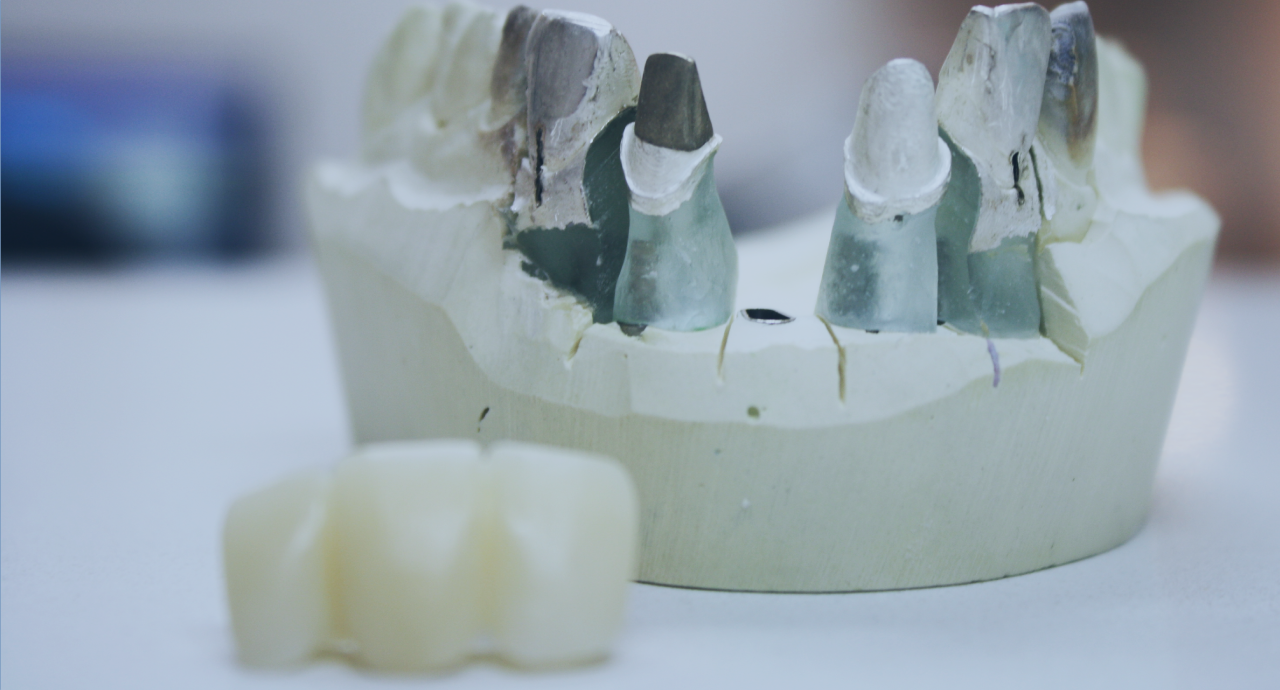
Missing teeth can be replaced in several ways. A missing tooth can be replaced using a dental implant. A dental implant is a cylindrical piece of Titanium which is surgically placed into the jawbone usually in the position of a missing tooth. Up to 2 teeth can be placed on a single dental implant. Once the implant has healed and the bone has attached to it, components can be placed onto it which replace a tooth in the mouth. The dental implant acts as a replacement of a tooth root which provides a support for a ceramic or gold and ceramic tooth replacement. This restoration is subtly different to a normal crown in that it replaces the component of the tooth which fits through the gum to the bone level. This restoration is often in two components. The components are called an abutment and a crown. Images of previous cases can demonstrate these 2 components. The implant is placed surgically usually by a Periodontist or an Oral Surgeon. These clinicians are dental specialists in the surgical management of the jaw bones, gums, and vital structures which are found in these areas. These vital structures include arteries, nerves, and sinuses.
What is the process for getting a dental implant – single tooth replacement?
Examination and Consultation
Replacing a tooth with a dental implant is a significant dental procedure. As a dental implant is placed within bone, an assessment of the volume of bone available in the proposed area is required. Usually when a tooth has been missing for a period of time, bone will shrink and resorb. In some cases, it is necessary to replace this bone or add to what is remaining. In addition to this, the shape and position of the gum is also important if the tooth to be replaced is in a visible area. The final aesthetics or appearance will be influenced not only by the tooth shape and colour but also by the condition of the gum around the implant crown. A dental implant restoration is normally a very long-term treatment and can possibly last for more than 20 or 30 years. It is necessary to check the surrounding teeth to make sure that they are in good condition and will not be lost in the short-term. An assessment of how much force someone places through their teeth when chewing, eating, and clenching is required as dental implants, abutments, and crowns can be made from different materials. The amount of force exerted on these will influence what type of material, as well as which type of implant, is used.
The Procedure
Preparation
If a dental implant is to replace an existing damaged or hopeless tooth, of course this tooth will require extraction. Usually this is replaced by a temporary single-tooth denture. The extraction site will often be left to heal for approximately 2 months. Following this, a dental implant is placed surgically. Dental implants normally take between 10 and 12 weeks to heal. Once the dental implant has healed successfully and has attached to the jawbone, an impression of this is taken along with a record of the way the teeth close together and the opposing teeth. In addition to this, a record of the colour and shape of the adjacent teeth is also taken along with images and photographs. Approximately 2 or 4 weeks following this, the final abutment and crown is delivered. This is placed on a temporary basis so that the appearance and function can be assessed. This temporary stage is usually 4 weeks. Following this any further adjustments or changes are made and the implant is placed permanently.
Care
Implants need to be cleaned regularly. Dental floss is essential to ensure that the bacteria is removed from the junction between the implant and the gum. Smoking is a major risk factor. Failure of implants which is rare, is usually associated with smoking. Dental implants need to be checked regularly as do all the teeth. Normal dental check-ups along with regular flossing is usually all the care that is required to maintain a dental implant into the long-term. Dental implant restorations of single teeth, if carried out correctly using the best materials, are excellent long-term restorations of individual or multiple teeth.


